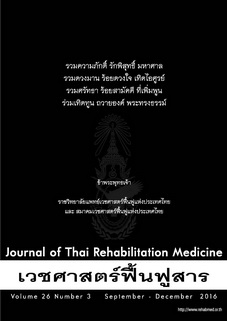ลักษณะทางคลินิกของผู้ป่วยโรค myelomeningocele ใน โรงพยาบาลศิริราชระหว่างปี พ.ศ. 2554-2555
ลักษณะทางคลินิกของผู้ป่วยโรค myelomeningocele ใน โรงพยาบาลศิริราชระหว่างปี พ.ศ. 2554-2555
Keywords:
myelomeningocele, congenital anomaly, neural tube defectAbstract
Objective: To study clinical characteristics of patients with myelomeningocele (MMC) in Siriraj Hospital.
Study design: Descriptive study
Setting: Medical record division, Siriraj Hospital
Subjects: All patients with MMC treated at Siriraj Hospital during 2011-2012.
Method: Retrospective review chart of all subjects
Results: One hundred sixteen chart of patients with MMC were studied. Forty seven percent of patients were children aged between 0-5 while 34 percent were children aged between 6-10. Hydrocephalus was the most associated clinical finding (36%). All of the total patients were divided into two groups. The first group was inpatients presenting with sacral or back mass that required surgical management (41%). The second group was outpatients presenting with complications
(59%). The most common complication was urinary complication(54%). Others were joint contractures or deformities, ambulationproblems and chronic wounds. Inpatients referred to rehabilitationdepartment received multidisciplinary care more than outpatients.Most patients who visited rehabilitation department had upper lumbar motor level (L1-L3) while the others had sacral motor level.
Conclusion: Most patients were children. There were outpatients more than inpatients. Several complications were found in many organ systems. Multidisciplinary clinic should be established in order to enable these patients to receive more appropriate treatments.
References
2. Ornoy A. Neuroteratogens in man: an overview with special emphasis on the teratogenicity of antiepileptic drugs in pregnancy. Reprod Toxicol. 2006;22:214-26.
3. Au KS, Ashley-Koch A, Northrup H. Epidemiologic and genetic aspects of spina bifida and other neural tube defects. Dev Disabil Res Rev. 2010;16:6-15.
4. Copp AJ, Greene NDE. Neural tube defects-disorders of neurulation and related embryonic processes. Wiley Interdiscip Rev Dev Biol. 2013;2:213-27.
5. Alexander MA, Matthews DJ. Pediatric rehabilitation principles and practice. 4th ed. New York: Demos medical publishing; 2010.
6. Dolk H, de Wals P, Lechat MF, Ayme S, Beckers R, Bianchi F, et al. Prevalence of neural tube defects in 20 regions of Europe and the impact of prenatal diagnosis, 1980-1986. J Epidemiol Community Health. 1991;45:52-8.
7. Ratanasiri T, Piensriwatchara E , Prasertcharoensuk W, Komwilaisak R. Birth prevalence of neural tube defects at Srinagarind hospital, 1988-1996. Srinagarind Med J. 1997;12:139-143.
8. Jaruratanasirikul S, Kor-anantakul O, Limpitikul W, Dissaneevate P, Khunnarakpong N, Sattapanyo A. Prevalence of neural tube defect in sounthern Thailand: a population-based survey during 2009-2012. Child Nerv Syst. 2014;30:1269-75.
9. Wasant P, Sathienkijkanchai A. Neural tube defects at Siriraj hospital, Bangkok, Thailand-10 years review (1990- 1999). J Med Assoc Thai. 2005;88:S92-9.
10. Veenboer PW, Bosch JLHR, van Asbeck FWA, de Kort LMO. Upper and lower urinary tract outcomes in adult myelomeningocele patients : a systematic review. PLoS One. 2012;7(10): e48399. doi:10.1371/journal.pone. 0048399.
11. Mantiang S, Vichiansiri R, Wattanapan P. The prevalence of vesicoureteric reflux in patients with myelomeningocele at Srinagarind hospital. J Thai Rehabil Med. 2011;2:63-7.
12. Roach JW, Short BF, Saltzman HM. Adult consequences of spina bifida. Clin Orthop Relat Res. 2011;469: 1246-52.
13. Brei TJ. The future of multidisciplinary clinic. Scientific World Journal. 2007; 7: 1752-6.
14. Alexiou GA, Zarifi MK, Georgoulis G, Mpouza E, Prodromou C, Moutafi A, et al. Cerebral abnormalities in infants with myelomeningocele. Neurologia i Neurochirurgia Polska. 2011; 45: 18-23.
15. Lindquist B, Uvebrant P, Rehn E, Carlsson G. Cognitive functions in children with myelomeningocele without hydrocephalus. Childs Nerv Syst. 2009;25:969-75.






